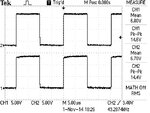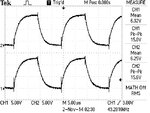P.Copper
Member level 5
Hi y'all
I'm trying to drive the MOSFET directly with the PWM. I generated a PWM signal using dspic30f4011 and because the MOSFET needs atleast 10V to switch on. I then used a MOSFET gate driver (HCPL 3120) to boost the voltage.
I get a nice clean gate signal but immediately when i connect the PWM signal to the MOSFET the gate signal changes from this to this
to this . can someone help me with this. Thanks
. can someone help me with this. Thanks
I'm trying to drive the MOSFET directly with the PWM. I generated a PWM signal using dspic30f4011 and because the MOSFET needs atleast 10V to switch on. I then used a MOSFET gate driver (HCPL 3120) to boost the voltage.
I get a nice clean gate signal but immediately when i connect the PWM signal to the MOSFET the gate signal changes from this
 to this
to this . can someone help me with this. Thanks
. can someone help me with this. Thanks